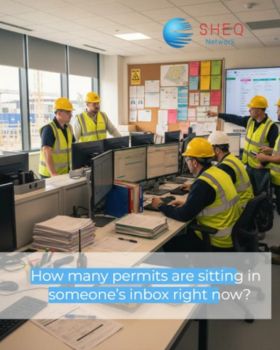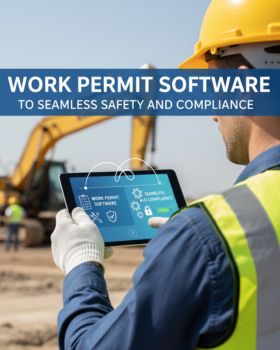1. What a Work Permit Really Means — And Why It Matters
Behind every high-risk task, there is a simple expectation: everyone should know exactly what is happening, who is responsible, and what safety measures must be in place. A safe work permit provides that clarity. It documents the scope of work, checks hazards, confirms isolations, and ensures that all required precautions are completed before any activity begins.
However, when permits are stored in folders, emails, or spreadsheets, the process begins to lose control. Approval chains become unclear. Isolation steps may not be verified. Supporting documents such as RAMS or gas tests can get misplaced. Without real-time visibility, a small oversight can quickly escalate into a serious safety incident.
This is why organizations treat the work permit as more than a piece of paper. It is a structured safety control, a communication tool, and a record of accountability. A strong work permit system in safety could help ensure that everyone — from engineers to contractors — understands what conditions must be met before work starts and what must be monitored during the job.
High-risk operations need coordination, not assumptions. A well-designed work permit provides that foundation.
2. How a Work Permit Should Be Managed for Maximum Safety
Managing permits effectively means moving away from fragmented methods and building a system that captures every step with consistency. A digital permit to work system software achieves this by centralizing the entire process.
In an ideal setup, each permit is created within a structured workflow. The issuer defines the work, reviews hazards, attaches RAMS, and requests isolations if necessary. Reviewers and approvers see the permit instantly, reducing delays. No one has to search through emails or chase signatures; the system routes tasks automatically.
This approach also allows teams to attach supporting documentation directly to the permit itself. Gas test readings, isolation confirmations, fire-watch arrangements, and photographs can all be stored within the same record. Having everything in one place could help reduce the possibility of a critical check being missed.
Real-time visibility is equally important. Supervisors and safety teams should be able to see which permits are active, which are pending approval, and which are overdue for closure. This helps decision-makers understand what work is happening on-site at any moment and avoid overlapping high-risk tasks.
A good system also recognises that many operations involve external workers. That is why a robust work permit for contractors is essential. By verifying the contractor’s credentials, linking them to the permit, and tracking their approvals in the same workflow, organizations ensure that external teams follow the same safety standards as internal staff.
These capabilities turn a permit from a procedural form into an operational control — one that protects people and provides clear, organized documentation for audits or incident reviews.
3. Why Our Method of Managing Work Permits Is a Stronger Approach
The method used in the mai™ Work Permit System aligns with the structured model we discussed in earlier strategy calls — first define what the permit process is, then understand how it should be managed, and finally apply a system that solves the gaps in traditional approaches.
The mai™ platform brings every permit into a single dashboard. Instead of scattering information across spreadsheets or paper files, the system centralizes creation, review, and approval. This ensures all stakeholders see the same information and reduces the chances of miscommunication.
One major advantage is traceability. Every action — creation, review, approval, or closure — is timestamped automatically. That means teams always have proof of who authorized what, when they did it, and what information they reviewed at the time. This level of detail could help during audits or post-incident investigations, where clarity matters most.
Another key strength of our method is the ability to attach all safety-critical records directly to each permit. RAMS, isolation evidence, gas test results, photographs, and fire-watch details become part of a single, traceable chain. This avoids the common problem of missing documentation and ensures each permit contains the full safety story from start to finish.
The system also supports multiple sites and teams. Organizations with complex operations often struggle to maintain consistent procedures across locations. A centralized platform standardizes workflows, making sure each team follows the same process, regardless of where the work is happening. This consistency could help reduce risk and improve communication between contractors, engineers, and safety personnel.
Finally, the mai™ system is built to enhance control without increasing paperwork. The goal is not to create more forms but to provide evidence that the right checks were completed. Work becomes safer not because more documents exist, but because the system ensures the right people approve the right steps at the right time.
This is the approach we discussed previously — a structured method that explains what the work permit is, how it should be managed, and why a digital solution creates a more reliable and accountable process.
Conclusion
A safe work permit has always been a crucial tool for controlling high-risk tasks. But traditional, paper-based methods limit visibility, slow down approvals, and make it difficult to maintain a clear record of safety checks. Fragmented data creates uncertainty, and uncertainty is where incidents begin.
By adopting modern work permit solutions, organizations can move toward a system that centralizes all permits, connects teams, stores every supporting document, and maintains a full audit trail. A digital permit to work system software brings structure, consistency, and accountability — and that could help create a stronger, more proactive safety culture.
The mai™ Work Permit System demonstrates how a digital approach transforms the permit process. It keeps teams aligned, ensures transparency, and maintains traceability from initiation to closure. With features designed for multi-site operations and contractor involvement, it provides a reliable foundation for safe, controlled, and well-documented work.
To learn more or to see how this integration could help streamline your operations, visit SHEQ Network’s Work Permit Software and reach out today to start your trial.
Book your personalized demonstration today and discover how the mai™ integrated suite could help transform your workplace health and safety journey.
📞 Contact Us:
USA: +1 (941) 337-167
Ireland: (+353) 21 4536034
UK: (+44) 800 8021092
🚀 Learn how SHEQ Network can support safer workflows!
📧 info@sheqnetwork.com
🔗 Learn more at sheqnetwork.com




